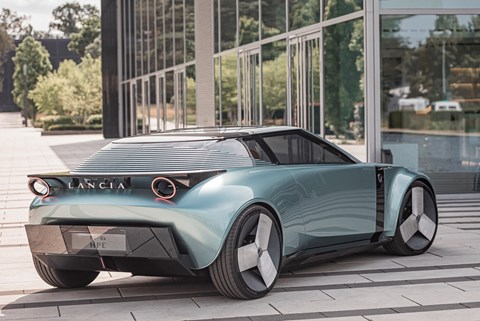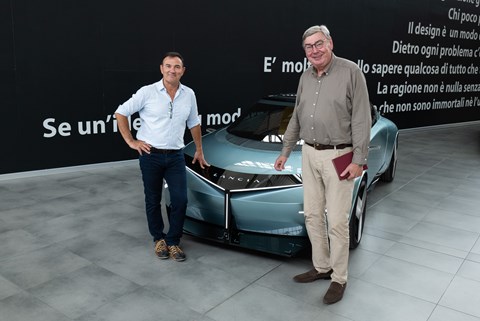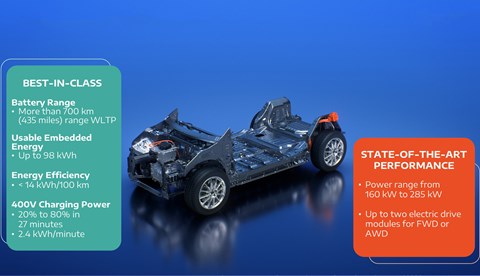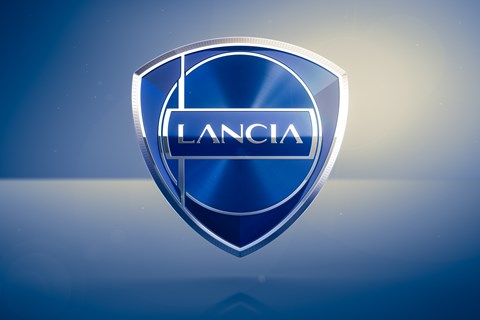► Lancia previews new design language
► Art sculpture and new logo revealed
► New Ypsilon, Delta and ‘new flagship’ confirmed
While the big-name brands like Fiat, Peugeot, Dodge and Jeep are the cornerstones of the ambitious plans of Carlos Tavares and his Stellantis team, hidden crown jewels in the shape of Alfa Romeo, DS and Lancia are yet to be brought into the open and given their time to shine.
The three upmarket brands have been grouped together into a still-fragile and underfunded group called the Premium Cluster. Why bother with Lancia instead of pulling out all the stops at Alfa? Because while car makers can buy batteries, microchips, tyres, steel and paint readily enough, tradition, heritage and history are not so easily acquired. You either have it or you don’t, and Lancia happens to possess it in bulk.
Trouble is, the heyday of the former style and tech leader is long gone. Customers craving the latest trends have a short memory, and Lancia has been a shadow of its formerly glorious self for so long that the name means nothing, or nothing good, to a lot of people. Under the Fiat umbrella, self-declared experts decided that cars like the Fulvia, Montecarlo, Stratos and Delta Integrale no longer matched the image, which had been in a constant state flux since the ’90s.
As it became more intertwined with Alfa Romeo, Lancia was forced to focus on a luxurious rather than sporty image, and we all know how that ended. The road to oblivion was paved with disasters like Lybra, Kappa, Prisma, Gamma, Zeta and Delta III. But the true nadir came when the brand fell prey to Chrysler, a tragic fate which produced a series of shameful caricatures like Flavia, Thema III and Voyager. The one model that remained true to its original mission throughout its lifetime was the Ypsilon, now built in Poland on an ancient Fiat-Ford platform but still ranking among the three best-selling small cars in Italy.
Lancia’s electric future: the Italianitá revolution

The new term being thrown around is Italianitá, which is about flair, emotion and a positive gut feeling. And it all started with the radical Pu+Ra HPE concept revealed earlier this year.
It’s certainly bold, with a wedge shape clearly influenced by the Stratos but pushed to an extreme that could easily be polarising. Inside, the outlandish user interface is too sophisticated for its own good. The driver environment is fully digitised, with one eye on eventually becoming self-driving, and looks more like a high-end living room than the cockpit of car.
‘All the cues of our new design DNA are already in place – the T-pattern front-end graphics, the trad round tail lights, the flush large-diameter wheels and the airy greenhouse with the wraparound back light,’ says chief designer Jean-Pierre Ploué (pictured below left), ‘not to forget select subtle signature elements which are a nod to the HPE, Stratos and Delta.’

Francesco Colonnese, in charge of business development at Lancia, promises: ‘Our cars will fuse Italian elegance with functional simplicity. Looking back on 116 years of mostly glorious history, we don’t want to be big. But we want to be in the right place with the right products.’
The brand’s largest cult following outside Italy is in Japan. Although the target volumes are relatively small, it therefore seems certain that Lancia will again build right-hand-drive models for Japan, the UK, South Africa and Australia.
Lancia’s first EVs: Ypsilon and Aurelia
‘The first car is the new Ypsilon,’ says Ploué. ‘The proportions are as low as can be, and the shape is quite aerodynamic for a compact hatchback.’ That new hatch is based on the group’s eCMP platform also used by the Vauxhall Mokka Electric, Peugeot 208, DS 3 Crossback and Jeep Avenger, among others. To be assembled in Zaragoza, the future Y sheds its trad sub-compact three-door hatchback body for the roomier proportions of a five-door crossover measuring about four metres in length. Like the Avenger it’ll also be available with mild-hybrid combustion engines for select markets, as well as a full battery-electric version.

Then Lancia will start to capitalise on the group’s upcoming set of STLA platforms, with the STLA Medium architecture (pictured above) providing a solid backbone for the Italian brand’s future models. Medium is designed for family cars, hatchbacks and crossovers and features new lightweight electric motors (with total power outputs topping out at almost 500bhp), and two battery sizes (87 and 104kWh) that are low-cost, high-density and free of nickel and cobalt. STLA Large, meanwhile, is for grand tourers, larger SUVs and performance cars. It has an 800-volt architecture for faster charging, high power outputs (more than 1000bhp is possible with three e-motors) and long range claims. While STLA Large suits the US arm of Stellantis rather well, both Lancia and Alfa are set to benefit, too, including various engineering trickeries such as steer- and brake-by-wire along with lateral, longitudinal and vertical vehicle motion control and a more sophisticated level of automated driving.
Lancia’s first STLA car will be a coupe-SUV, expected to launch in 2026 and likely called Aurelia. The sleek, low-drag eye-catcher shares the STLA Medium architecture with the all-new Peugeot e-3008. Built in Melfi, the Aurelia is described as a mix between a high five-door coupe and a low five-seat crossover.
Since so much of the hardware will be shared, Alfa and DS will have to use every trick in the book to convince their target buyers that they are offering distinct products. That’s why we expect the Pu+Ra’s key styling features – like the triple-ray front-end graphics and the floating round tail lights – to make it into production.
New Lancia Delta due in 2028; grand tourer on the cards
Although many Lancia aficionados were hoping a new Delta would follow hot on the heels of the Ypsilon, we must wait until 2028 for the reborn icon. Like Gamma, Delta will tap the STLA Medium platform alongside the next-generation Vauxhall Astra, Peugeot 308 and DS 4. While it will clock in at a similar length to its siblings, insiders expect the Lancia to be wider, lower, bolder, emphatically aerodynamic and aggressively sporty. The trademark flared wheelarches, adaptive air deflectors all-round and a variable-tint coupe-like greenhouse should also be part of the layout.
The driver focus will be emphasised by a four-seat cabin with buckets front and rear, and digital multi-mode instrumentation. A radical, high-performance HF specification will be on offer.
If all goes according to plan, the Gamma – inside Lancia known as New Thema – will complete the range in 2030. Based on the STLA Large components set, this is the sister model of the next-generation Alfa Giulia and Stelvio. If the Thema does materialise, it will probably be an elegant, sporty, sophisticated and rather costly GT/saloon crossbreed designed to compete against the Lucid Air, Tesla Model S and Audi’s new ‘Landjet’ A8 super-limo.
A Thema coupe, shooting brake and even a high-performance off-roader inspired by the Lamborghini Huracan Sterrato are on the drawing board, too.

In its 10-year strategic plan mapped out in 2021, Lancia’s mission talks of ‘effortless electrification with a twist,’ and insists the brand’s ‘highly personalised customer experience needs to be very special.’ We’ve not seen ambition like this from Lancia in years, with a team that’s buoyed by Stellantis backing. ‘We were a team of three and we started from scratch a little over two years ago,’ says Ploué. ‘The mission was to connect the design of the past – one of Lancia’s key legacies – to the design of the future.’
But are we being over-optimistic in thinking Lancia can be revived in this way? Or can an exquisite product portfolio, a charming Italo-centric brand image and a nonconformist approach to design create enough momentum to turn an almost forgotten brand into one strong enough to carve out a niche of its own? We’re inclined to believe that Lancia is in with a chance. Since power, torque and performance are about to become common commodities, differentiation must find new emotional roots, the user experience is bound to play a much bigger role, and even a small car maker can succeed if it ticks enough of those boxes.
In the case of Lancia, it is crucial to exorcise the bugs of the past like ho-hum quality, lacklustre presentation and middle-of-the-road dynamics while simultaneously introducing an intriguing fresh blend of best-in-class charge times, range and consumption fused with a young, sustainable, progressive and highly individual lifestyle.